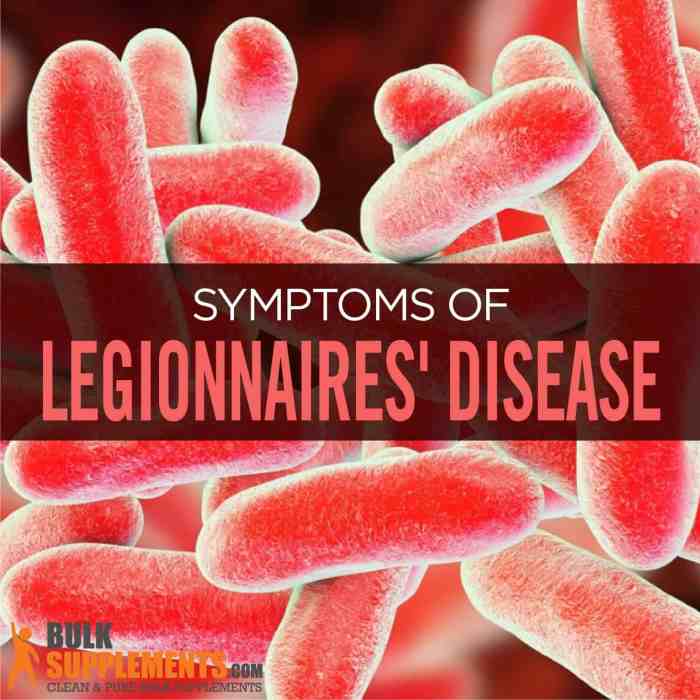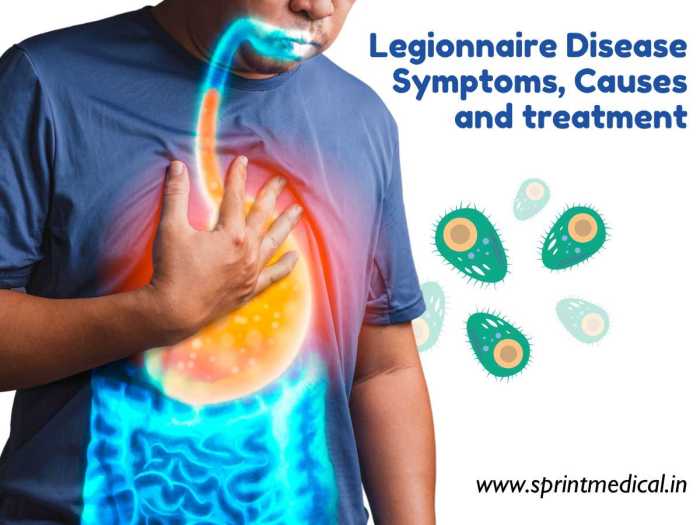Legionnaires symptoms – Legionnaires’ disease is a severe lung infection caused by Legionella bacteria. Understanding its symptoms is crucial for early detection and effective treatment. This article delves into the various symptoms associated with Legionnaires’ disease, their severity, and duration.
Legionnaires’ disease can manifest with a range of symptoms, including fever, chills, muscle aches, headache, and fatigue. In severe cases, it can lead to pneumonia, shortness of breath, and organ failure.
Legionnaires’ Disease Symptoms: Legionnaires Symptoms
Legionnaires’ disease is a severe form of pneumonia caused by the bacteria Legionella. Symptoms typically appear within 2-10 days of exposure to the bacteria and can range in severity from mild to life-threatening.
Common symptoms of Legionnaires’ disease include:
- High fever (over 104 degrees Fahrenheit)
- Chills
- Muscle aches
- Headache
- Nausea and vomiting
- Diarrhea
- Confusion
- Shortness of breath
- Chest pain
The severity of Legionnaires’ disease can vary widely, and some people may experience only mild symptoms, while others may develop severe pneumonia and require hospitalization. In severe cases, the disease can be fatal.
Causes and Transmission, Legionnaires symptoms

Legionnaires’ disease is caused by the bacteria Legionella pneumophila. The bacteria are found naturally in water sources, such as lakes, rivers, and ponds. They can also be found in man-made water systems, such as cooling towers, hot tubs, and showers.
People become infected with Legionnaires’ disease when they inhale aerosolized water droplets that contain the bacteria. This can happen when water is aerosolized through devices such as showers, faucets, and cooling towers.
Legionnaires’ disease is not spread from person to person.
Risk Factors
Anyone can develop Legionnaires’ disease, but some people are at an increased risk, including:
- People over the age of 50
- People with weakened immune systems
- People with chronic lung conditions, such as emphysema or chronic bronchitis
- People who smoke
- People who have recently traveled to an area where Legionnaires’ disease is common
Diagnosis and Treatment
Legionnaires’ disease is diagnosed based on the patient’s symptoms and a physical examination. The doctor may also order a chest X-ray or a blood test to confirm the diagnosis.
Legionnaires’ disease is treated with antibiotics. The antibiotics are typically given intravenously (IV) in the hospital. Treatment usually lasts for 5-10 days.
Most people with Legionnaires’ disease recover fully with treatment. However, some people may develop complications, such as pneumonia, sepsis, or respiratory failure.
Prevention and Control

There are a number of things that can be done to prevent and control Legionnaires’ disease, including:
- Maintaining water systems properly
- Cleaning and disinfecting cooling towers and other water systems regularly
- Using filters to remove Legionella bacteria from water
- Educating people about the risks of Legionnaires’ disease
Related Conditions
![]()
Legionnaires’ disease can be associated with other health conditions, such as:
- Pneumonia
- Sepsis
- Respiratory failure
- Kidney failure
- Liver failure
Legionnaires’ disease can also lead to long-term health problems, such as:
- Chronic fatigue
- Shortness of breath
- Muscle weakness
- Cognitive impairment
Final Conclusion
Legionnaires’ disease is a potentially serious infection, but timely diagnosis and treatment can significantly improve outcomes. By recognizing the symptoms and seeking medical attention promptly, individuals can minimize the risk of complications and ensure a full recovery.
Commonly Asked Questions
What are the early symptoms of Legionnaires’ disease?
Early symptoms include fever, chills, muscle aches, headache, and fatigue.
How is Legionnaires’ disease diagnosed?
Diagnosis is made through urine or respiratory samples that are tested for the presence of Legionella bacteria.
What is the treatment for Legionnaires’ disease?
Treatment typically involves antibiotics and supportive care to manage symptoms and prevent complications.